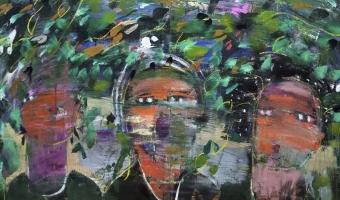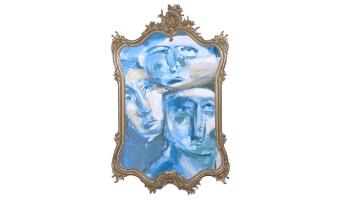A Painted Book of Life, Time and Feelings
Peaceful veils, crying veils, happy veils, tired veils, stillness veils, scared veils, indecisive veils, absorbed veils... not faces, just veils...
Using detailed black-and-white female figures painted in oil and charcoal characterizes Lincoln’s work. Focusing his interest in the action of the daily life narratives, he covers the faces of his characters to imbue them just with feelings and emotions.
Lincoln’s interest goes beyond history, seeking to explore the untold micro-histories. It is almost a thoughtful exercise of contemplation. This exhibition includes a body of work that assembles altogether as storytelling, creating a narrative of existentialism. Through the correlations between different archetypes, the drama comes from the subtle tensions inside the cycles of life, and the unconscious feelings that arise from them.
Lincoln’s body of work is drenched in pure symbolism; the characters and elements in the paintings do not have an identity. They are but archetypes that embody the fundamental characteristics of a concept representing many of them. We have human, animals, plants, food and color characters, acting as metaphors that embody multiple concepts. All these elements together form a personal code that gives hints to many interpretations. Lincoln masterfully creates his language through painting, colors, and symbolism. All of this makes this original exhibition an endless painted book of life, time, and feelings.
The inspiration for painting emotions came to him after watching some videos of waterboarded torture, it fascinated him that he could not see the identity of the person being tortured, but could still see, through the veil, a range of emotions. Lincoln is also deeply inspired by the symbolism of the Dutch painter Hieronymus Bosch, and the capacity to compress complex actions in a few characters as in the paintings of the Belgian artist Jan van Eyck.
The only human character, Wangari, is the archetype of mother nature, and the unconscious. The artist veils her face to conceal her identity, as Wangari is not one but a representation of many. Even though she still keeps part of her identity as an individual. The name originates from “angare” the root of one of Lincoln’s family names as a metaphor for everyone’s mother. In the triptych Silence I, Pleasure, and Silence II, Lincoln is painting how the pleasure moves, even unconsciously, we can find ephemeral instances of pleasure in daily life, but pleasure is not static, it moves from one space to another.
The two animal characters that appear in Lincoln’s work are the Goat and the Egret. The goat is a metaphor for the ground and the egret for the sky. These two characters give us a hint of where the scene is. The Egret represents the feminine in motion, because the other female character, Wangari, is always motionless. The Goat is the masculine character; it represents the sacrifice. It feeds on leaves but is itself food. The characters change their roles depending on how the elements appear on the scene, creating instances of peace or tension. Food represented by the bananas, and ropes represent influences and attachments as they are symbols that bring people together.
The colors in the background of Lincoln’s paintings are also archetypes; Black represents the night, and shadows; Blue is the day and the reflection of the sky in the water; Red is the instant, the sunrise, the sunset, the sacrifice, and the fire; White is light and space.
In the Diptychs Road to Black I and II, the artist talks about the sacrifice (red) during the day (blue) and the reward of the shade (black) on a hot day, or the reward of a restful night after an intense day of work. He portrays the cycle of sacrifice and pleasure; day and night; action and inaction.
The drama lives in the life cycles, in the dualities, the day and the night, the light and the shadows, the sun and the moon. It is also present in the time, in the silence, in the indecision, in the sacrifice, in the transitions, in the constant changes. Sometimes we are not aware of it. It is an unconscious discomfort or pleasure. There are many possibilities, many principles, many resolutions, some impossible choices, and multiple ends.
Using detailed black-and-white female figures painted in oil and charcoal characterizes Lincoln’s work. Focusing his interest in the action of the daily life narratives, he covers the faces of his characters to imbue them just with feelings and emotions.
Lincoln’s interest goes beyond history, seeking to explore the untold micro-histories. It is almost a thoughtful exercise of contemplation. This exhibition includes a body of work that assembles altogether as storytelling, creating a narrative of existentialism. Through the correlations between different archetypes, the drama comes from the subtle tensions inside the cycles of life, and the unconscious feelings that arise from them.
Lincoln’s body of work is drenched in pure symbolism; the characters and elements in the paintings do not have an identity. They are but archetypes that embody the fundamental characteristics of a concept representing many of them. We have human, animals, plants, food and color characters, acting as metaphors that embody multiple concepts. All these elements together form a personal code that gives hints to many interpretations. Lincoln masterfully creates his language through painting, colors, and symbolism. All of this makes this original exhibition an endless painted book of life, time, and feelings.
The inspiration for painting emotions came to him after watching some videos of waterboarded torture, it fascinated him that he could not see the identity of the person being tortured, but could still see, through the veil, a range of emotions. Lincoln is also deeply inspired by the symbolism of the Dutch painter Hieronymus Bosch, and the capacity to compress complex actions in a few characters as in the paintings of the Belgian artist Jan van Eyck.
The only human character, Wangari, is the archetype of mother nature, and the unconscious. The artist veils her face to conceal her identity, as Wangari is not one but a representation of many. Even though she still keeps part of her identity as an individual. The name originates from “angare” the root of one of Lincoln’s family names as a metaphor for everyone’s mother. In the triptych Silence I, Pleasure, and Silence II, Lincoln is painting how the pleasure moves, even unconsciously, we can find ephemeral instances of pleasure in daily life, but pleasure is not static, it moves from one space to another.
The two animal characters that appear in Lincoln’s work are the Goat and the Egret. The goat is a metaphor for the ground and the egret for the sky. These two characters give us a hint of where the scene is. The Egret represents the feminine in motion, because the other female character, Wangari, is always motionless. The Goat is the masculine character; it represents the sacrifice. It feeds on leaves but is itself food. The characters change their roles depending on how the elements appear on the scene, creating instances of peace or tension. Food represented by the bananas, and ropes represent influences and attachments as they are symbols that bring people together.
The colors in the background of Lincoln’s paintings are also archetypes; Black represents the night, and shadows; Blue is the day and the reflection of the sky in the water; Red is the instant, the sunrise, the sunset, the sacrifice, and the fire; White is light and space.
In the Diptychs Road to Black I and II, the artist talks about the sacrifice (red) during the day (blue) and the reward of the shade (black) on a hot day, or the reward of a restful night after an intense day of work. He portrays the cycle of sacrifice and pleasure; day and night; action and inaction.
The drama lives in the life cycles, in the dualities, the day and the night, the light and the shadows, the sun and the moon. It is also present in the time, in the silence, in the indecision, in the sacrifice, in the transitions, in the constant changes. Sometimes we are not aware of it. It is an unconscious discomfort or pleasure. There are many possibilities, many principles, many resolutions, some impossible choices, and multiple ends.




